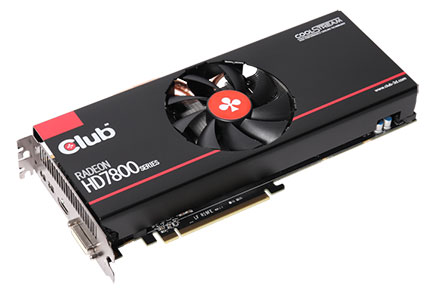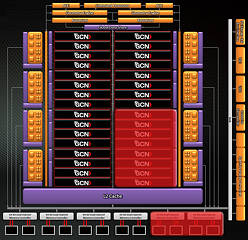 31
31
Club 3D HD 7870 jokerCard Tahiti LE 2 GB Review
Packaging & Contents »Introduction

Towards late-November, AMD made a halfhearted attempt at launching a new performance-segment GPU that strikes a price-point right in between the Radeon HD 7870 GHz Edition and the Radeon HD 7950, and that's putting it mildly. There was confusion over specifications and name until the very last minute. AMD finally decided not to make a reference-design card which left the decision to its partners, most of whom decided against releasing the SKU so as not to disturb their swelling HD 7870 GHz Edition and HD 7950 inventories. To make matters worse, AMD chose the brilliant SKU name of "Radeon HD 7870."

Amongst the only AMD board partners that opted to make cards based on this chip, which has been codenamed "Tahiti LE," are those that rely on contract manufacturer TUL Corporation. These board partners include Club3D, PowerColor, and VTX3D, and the latter two are even owned by TUL. Today, we have with us Club3D's contraption called the HD 7870 jokerCard;It is a part of Club3D's Poker Series.
AMD's new GPU is called "Tahiti LE" even though it's a part of the Radeon HD 7800 series, because it is derived from the same 3.5 billion-transistor "Tahiti" silicon that goes into making all Radeon HD 7900 series products and not the "Pitcairn" silicon that goes into making the HD 7870 GHz Edition and HD 7850. The new SKU drops the "GHz Edition" moniker by featuring lower clock speeds than the HD 7870 GHz Edition, but it makes up for that with more pixel-crunching muscle.
The HD 7870 "Tahiti LE" is carved out of the Tahiti silicon by disabling a fourth of its Graphics CoreNext clusters, which results in a stream processor count of 1,536, a texture memory unit (TMU) count of 96, and a raster operations processor (ROP) count of 32. The memory bus width has been reduced by a third; now, it is 256-bit wide and holds 2 GB of memory. The new chip features PowerTune with Boost: a dynamic core overclocking equivalent to NVIDIA's GPU Boost. The card ships with a GPU clock speed of 925 MHz, PowerTune boost clock of 975 MHz, and 6.00 GHz memory for a memory bandwidth of 192 GB/s.
| Radeon HD 6950 | GeForce GTX 570 | Radeon HD 6970 | Radeon HD 7850 | GeForce GTX 660 | Radeon HD 7870 | Club3D HD 7870 jokerCard | GeForce GTX 580 | GeForce GTX 660 Ti | Radeon HD 7950 | GeForce GTX 670 | Radeon HD 7970 | |
|---|---|---|---|---|---|---|---|---|---|---|---|---|
| Shader Units | 1408 | 480 | 1536 | 1024 | 960 | 1280 | 1536 | 512 | 1344 | 1792 | 1344 | 2048 |
| ROPs | 32 | 40 | 32 | 32 | 24 | 32 | 32 | 48 | 24 | 32 | 32 | 32 |
| Graphics Processor | Cayman | GF110 | Cayman | Pitcairn | GK106 | Pitcairn | Tahiti | GF110 | GK104 | Tahiti | GK104 | Tahiti |
| Transistors | 2640M | 3000M | 2640M | 2800M | 2540M | 2800M | 4310M | 3000M | 3500M | 4310M | 3500M | 4310M |
| Memory Size | 2048 MB | 1280 MB | 2048 MB | 2048 MB | 2048 MB | 2048 MB | 2048 MB | 1536 MB | 2048 MB | 3072 MB | 2048 MB | 3072 MB |
| Memory Bus Width | 256 bit | 320 bit | 256 bit | 256 bit | 192 bit | 256 bit | 256 bit | 384 bit | 192 bit | 384 bit | 256 bit | 384 bit |
| Core Clock | 800 MHz | 732 MHz | 880 MHz | 860 MHz | 980 MHz+ | 1000 MHz | 975 MHz | 772 MHz | 915 MHz+ | 800 MHz | 915 MHz+ | 925 MHz |
| Memory Clock | 1250 MHz | 950 MHz | 1375 MHz | 1200 MHz | 1502 MHz | 1200 MHz | 1500 MHz | 1002 MHz | 1502 MHz | 1250 MHz | 1502 MHz | 1375 MHz |
| Price | $170 | $250 | $380 | $185 | $230 | $245 | $270 | $430 | $280 | $310 | $380 | $390 |
Apr 24th, 2024 19:26 EDT
change timezone
Latest GPU Drivers
New Forum Posts
- Will a RTX 4070 TI super bottleneck a Ryzen 9 7950X3D? (58)
- The best *budget* ATX PC case on the market? (24)
- GTX 1070 Ti - TDP Issues - Always Power Throttling (4)
- The TPU UK Clubhouse (24782)
- 2022-X58/1366 PIN Motherboards NVME M.2 SSD BIOS MOD Collection (656)
- Meta Horizon OS (15)
- Is there a technical reason that Windows 11 doesn't have built into it battery charge limitation? (41)
- Best SSD for system drive (75)
- How are MX330 and İ5 1135G7 ? (9)
- 3DMARK "LEGENDARY" (189)
Popular Reviews
- Fractal Design Terra Review
- Thermalright Phantom Spirit 120 EVO Review
- Corsair 2000D Airflow Review
- Minisforum EliteMini UM780 XTX (AMD Ryzen 7 7840HS) Review
- ASUS GeForce RTX 4090 STRIX OC Review
- NVIDIA GeForce RTX 4090 Founders Edition Review - Impressive Performance
- ASUS GeForce RTX 4090 Matrix Platinum Review - The RTX 4090 Ti
- MSI GeForce RTX 4090 Gaming X Trio Review
- MSI GeForce RTX 4090 Suprim X Review
- Gigabyte GeForce RTX 4090 Gaming OC Review
Controversial News Posts
- Sony PlayStation 5 Pro Specifications Confirmed, Console Arrives Before Holidays (116)
- NVIDIA Points Intel Raptor Lake CPU Users to Get Help from Intel Amid System Instability Issues (106)
- AMD "Strix Halo" Zen 5 Mobile Processor Pictured: Chiplet-based, Uses 256-bit LPDDR5X (101)
- US Government Wants Nuclear Plants to Offload AI Data Center Expansion (98)
- Windows 10 Security Updates to Cost $61 After 2025, $427 by 2028 (84)
- Developers of Outpost Infinity Siege Recommend Underclocking i9-13900K and i9-14900K for Stability on Machines with RTX 4090 (84)
- TechPowerUp Hiring: Reviewers Wanted for Motherboards, Laptops, Gaming Handhelds and Prebuilt Desktops (78)
- AMD's RDNA 4 GPUs Could Stick with 18 Gbps GDDR6 Memory (70)
